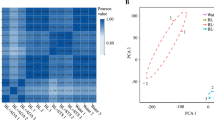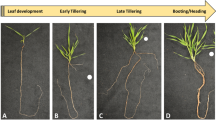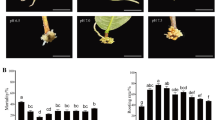Abstract
Spring-type canola produces significantly smaller and less vigorous roots than winter type at later growth stages. To identify the gene-regulatory networks and cross talks among phytohormones that may be responsible for the difference between the root system of the two growth types, we analyzed transcriptomes from the root samples collected at two time points, 30 and 60 days. Out of 169,646 transcripts that were analyzed, 582 and 555 transcripts were found to be significantly differentially expressed between spring and winter types at 30 and 60 days, respectively. Several auxin-responsive genes were significantly differentially expressed between spring and winter types at both time points, but no distinct pattern of differential regulation was observed in either of the growth types. Type-A and type-B ARABIDOPSIS RESPONSE REGULATOR (ARR) genes, and gene sets involved in cytokinin signaling pathway, were upregulated in the spring types at 60 days. This would be consistent with higher cytokinin activity, which is known to inhibit root growth, in spring type root system at the later growth stage. In addition, several gibberellin-responsive and gibberellin-signaling gene sets were also upregulated only in spring types at 60 days. We observed an elongated root system with fewer root branches in spring type compared to winter type at 60 days in this study, which is consistent with a role of gibberellin in root growth and development. Extensive gene expression data generated in this research will further assist in understanding the natural variation of root system in canola growth habits.






Similar content being viewed by others
Availability of data and material
Available at Sequence Read Archive (SRA) database no. SRP160988/ NCBI biproject accession # PRJNA490162.
References
Aida M, Beis D, Heidstra R et al (2004) The PLETHORA genes mediate patterning of the Arabidopsis root stem cell niche. Cell 119:119–120. https://doi.org/10.1016/j.cell.2004.09.018
Argyros RD, Mathews DE, Chiang Y-H et al (2008) Type B response regulators of Arabidopsis play key roles in cytokinin signaling and plant development. Plant Cell 20:2102–2116. https://doi.org/10.1105/tpc.108.059584
Arifuzzaman M, Mamidi S, Mcclean P, Rahman M (2016) QTL mapping for root vigor and days to flowering in Brassica napus L. Can J Plant Sci 109:99–109. https://doi.org/10.1139/cjps-2016-0048
Arifuzzaman M, Oladzadabbasabadi A, McClean P, Rahman M (2019) Shovelomics for phenotyping root architectural traits of rapeseed/canola (Brassica napus L.) and genome-wide association mapping. Mol Genet Genomics. https://doi.org/10.1007/s00438-019-01563-x
Arifuzzaman M, Rahman M (2017) A comparative study on root traits of spring and winter canola (Brassica napus L.) under controlled and water stressed conditions. J Agric Sci 9:58. https://doi.org/10.5539/jas.v9n7p58
Begara-Morales JC, Sánchez-Calvo B, Luque F et al (2014) Differential transcriptomic analysis by RNA-seq of GSNO-responsive genes between arabidopsis roots and leaves. Plant Cell Physiol 55:1080–1095. https://doi.org/10.1093/pcp/pcu044
Benjamins R, Scheres B (2008) Auxin: The looping star in plant development. Annu Rev Plant Biol 59:443–465. https://doi.org/10.1146/annurev.arplant.58.032806.103805
Bennett MJ, Marchant A, Green HG et al (1996) Arabidopsis AUX1 Gene: A permease-like regulator of root gravitropism. Science 273:948–950. https://doi.org/10.1126/science.273.5277.948
Berova M, Zlatev Z (2000) Physiological response and yield of paclobutrazol treated tomato plants (Lycopersicon esculentum Mill.). Plant Growth Regul 30:117–123. https://doi.org/10.1023/A:1006300326975
Billou I, Xu J, Wildwater M et al (2005) The PIN auxin efflux facilitator network controls growth and patterning in Arabidopsis roots. Nature 433:39–44. https://doi.org/10.1038/nature03184
Busov V, Meilan R, Pearce DW et al (2006) Transgenic modification of gai or rgl1 causes dwarfing and alters gibberellins, root growth, and metabolite profiles in Populus. Planta 224:288–299. https://doi.org/10.1007/s00425-005-0213-9
Chang S, Puryear J, Cairney J (1993) A simple and efficient method for isolating RNA from pine trees. Plant Mol Biol Report 11:113–116. https://doi.org/10.1007/BF02670468
Chapman EJ, Estelle M (2009) Mechanism of auxin-regulated gene expression in plants. Annu Rev Genet 43:265–285. https://doi.org/10.1146/annurev-genet-102108-134148
Chen C-Z, Lv X-F, Li J-Y et al (2012) Arabidopsis NRT1.5 is another essential component in the regulation of nitrate reallocation and stress tolerance. Plant Physiol 159:1582–1590. https://doi.org/10.1104/pp.112.199257
De La Fuente JI, Amaya I, Castillejo C et al (2006) The strawberry gene FaGAST affects plant growth through inhibition of cell elongation. J Exp Bot 57:2401–2411. https://doi.org/10.1093/jxb/erj213
De Smet I, Tetsumura T, De Rybel B et al (2007) Auxin-dependent regulation of lateral root positioning in the basal meristem of Arabidopsis. Development 134:681–690. https://doi.org/10.1242/dev.02753
Dello Ioio R, Nakamura K, Moubayidin L et al (2008) A genetic framework for the control of cell division and differentiation in the root meristem. Science 322:1380–1384. https://doi.org/10.1126/science.1164147
Dill A, Sun TP (2001) Synergistic derepression of gibberellin signaling by removing RGA and GAI function in Arabidopsis thaliana. Genetics 159:777–785
Dun X, Tao Z, Wang J et al (2016) Comparative transcriptome analysis of primary roots of Brassica napus seedlings with extremely different primary root lengths using RNA sequencing. Front Plant Sci. https://doi.org/10.3389/fpls.2016.01238
Ellis CM, Nagpal P, Young JC et al (2005) Auxin response factor1 and auxin response factor2 regulate senescence and floral organ abscission in Arabidopsis thaliana. Development 132:4563–4574. https://doi.org/10.1242/dev.02012
Ferreira FJ, Kieber JJ (2005) Cytokinin signaling. Curr Opin Plant Biol 8:518–525
Forzani C, Aichinger E, Sornay E et al (2014) WOX5 suppresses CYCLIN D activity to establish quiescence at the center of the root stem cell niche. Curr Biol 24:1939–1944. https://doi.org/10.1016/j.cub.2014.07.019
Fukaki H, Tasaka M (2009) Hormone interactions during lateral root formation. Plant Mol Biol 69:437–449
Galinha C, Hofhuis H, Luijten M et al (2007) PLETHORA proteins as dose-dependent master regulators of Arabidopsis root development. Nature 449:1053–1057. https://doi.org/10.1038/nature06206
Geisler M, Murphy AS (2006) The ABC of auxin transport: The role of p-glycoproteins in plant development. FEBS Lett 580:1094–1102. https://doi.org/10.1016/j.febslet.2005.11.054
Goldsmith M (1977) Polar transport of auxin. Annu Rev Plant Physiol Plant Mol Biol 28:439–478
Gou J, Strauss SH, Tsai CJ et al (2010) Gibberellins regulate lateral root formation in Populus through interactions with auxin and other hormones. Plant Cell 22:623–639. https://doi.org/10.1105/tpc.109.073239
Gray WM, Kepinski S, Rouse D et al (2001) Auxin regulates SCFTIR1-dependent degradation of AUX/IAA proteins. Nature 414:271–276. https://doi.org/10.1038/35104500
Greenboim-Wainberg Y (2005) Cross talk between gibberellin and cytokinin: The Arabidopsis GA response inhibitor SPINDLY plays a positive role in cytokinin signaling. Plant Cell Online 17:92–102. https://doi.org/10.1105/tpc.104.028472
Howe GT, Horvath DP, Dharmawardhana P et al (2015) Extensive transcriptome changes during natural onset and release of vegetative bud dormancy in Populus. Front Plant Sci 6:1–28. https://doi.org/10.3389/fpls.2015.00989
Huang X-Q, Huang T, Hou G-Z et al (2016) Identification of QTLs for seed quality traits in rapeseed (Brassica napus L) using recombinant inbred lines (RILs). Euphytica. https://doi.org/10.1007/s10681-016-1675-5
Hwang I, Sheen J (2001) Two-component circuitry in Arabidopsis cytokinin signal transduction. Nature 413:383–389. https://doi.org/10.1038/35096500
Kiba T, Krapp A (2016) Plant nitrogen acquisition under low availability: Regulation of uptake and root architecture. Plant Cell Physiol 57:707–714
Kong X, Lu S, Tian H, Ding Z (2015) WOX5 is shining in the root stem cell niche. Trends Plant Sci 20:601–603
Krapp A, David LC, Chardin C et al (2014) Nitrate transport and signalling in Arabidopsis. J Exp Bot 65:789–798
Lan P, Li W, Schmidt W (2012) Complementary proteome and transcriptome profiling in phosphate-deficient Arabidopsis roots reveals multiple levels of gene regulation. Mol Cell Proteomics 11:1156–1166. https://doi.org/10.1074/mcp.M112.020461
Laplaze L, Benkova E, Casimiro I et al (2007) Cytokinins act directly on lateral root founder cells to inhibit root initiation. Plant Cell Online 19:3889–3900. https://doi.org/10.1105/tpc.107.055863
Lau S, Shao N, Bock R et al (2009) Auxin signaling in algal lineages: fact or myth? Trends Plant Sci 14:182–188. https://doi.org/10.1016/j.tplants.2009.01.004
Li KL, Bai X, Li Y et al (2011) GsGASA1 mediated root growth inhibition in response to chronic cold stress is marked by the accumulation of DELLAs. J Plant Physiol 168:2153–2160. https://doi.org/10.1016/j.jplph.2011.07.006
Li W, Lan P (2015) Re-analysis of RNA-seq transcriptome data reveals new aspects of gene activity in Arabidopsis root hairs. Front Plant Sci 6:421. https://doi.org/10.3389/fpls.2015.00421
Ljung K, Bhalerao RP, Sandberg G (2001) Sites and homeostatic control of auxin biosynthesis in Arabidopsis during vegetative growth. Plant J 28:465–474. https://doi.org/10.1046/j.1365-313X.2001.01173.x
Lin S-H, Kuo H-F, Canivenc G et al (2008) Mutation of the Arabidopsis NRT1.5 nitrate transporter causes defective root-to-shoot nitrate transport. Plant Cell Online 20:2514–2528. https://doi.org/10.1105/tpc.108.060244
Lopez-Moya F, Escudero N, Zavala-Gonzalez EA et al (2017) Induction of auxin biosynthesis and WOX5 repression mediate changes in root development in Arabidopsis exposed to chitosan. Sci Rep. https://doi.org/10.1038/s41598-017-16874-5
Ludwig-Müller J (2011) Auxin conjugates: Their role for plant development and in the evolution of land plants. J Exp Bot 62:1757–1773. https://doi.org/10.1093/jxb/erq412
Mockaitis K, Estelle M (2008) Auxin receptors and plant development: A new signaling paradigm. Annu Rev Cell Dev Biol 24:55–80. https://doi.org/10.1146/annurev.cellbio.23.090506.123214
Moubayidin L, Perilli S, Dello Ioio R et al (2010) The rate of cell differentiation controls the Arabidopsis root meristem growth phase. Curr Biol 20:1138–1143. https://doi.org/10.1016/j.cub.2010.05.035
Müller A, Hillebrand H, Weiler EW (1998) Indole-3-acetic acid is synthesized from L-tryptophan in roots of Arabidopsis thaliana. Planta 206:362–369. https://doi.org/10.1007/s004250050411
Nacry P, Bouguyon E, Gojon A (2013) Nitrogen acquisition by roots: Physiological and developmental mechanisms ensuring plant adaptation to a fluctuating resource. Plant Soil 370:1–29
Nahirñak V, Almasia NI, Hopp HE, Vazquez-Rovere C (2012) Snakin/GASA proteins: Involvement in hormone crosstalk and redox homeostasis. Plant Signal Behav 7(8):1004–1008. https://doi.org/10.4161/psb.20813
Nikitin A, Egorov S, Daraselia N, Mazo I (2003) Pathway studio–the analysis and navigation of molecular networks. Bioinformatics 19:2155–2157. https://doi.org/10.1093/BIOINFORMATICS/BTG290
Okushima Y, Fukaki H, Onoda M et al (2007) ARF7 and ARF19 regulate lateral root formation via direct activation of LBD/ASL genes in Arabidopsis. Plant Cell Online 19:118–130. https://doi.org/10.1105/tpc.106.047761
Okushima Y, Mitina I, Quach HL, Theologis A (2005) Auxin response factor 2 (ARF2): A pleiotropic developmental regulator. Plant J 43:29–46. https://doi.org/10.1111/j.1365-313X.2005.02426.x
Overvoorde P, Fukaki H, Beeckman T (2010) Auxin control of root development. Cold Spring Harb. Perspect Biol 2
Pacifici E, Polverari L, Sabatini S (2015) Plant hormone cross-talk: the pivot of root growth. J Exp Bot 66:1113–1121
Petrasek J, Friml J (2009) Auxin transport routes in plant development. Development 136:2675–2688. https://doi.org/10.1242/dev.030353
Petricka JJ, Winter CM, Benfey PN (2012) Control of Arabidopsis Root Development. Annu Rev Plant Biol 63:563–590. https://doi.org/10.1146/annurev-arplant-042811-105501
Rahman M, McClean P (2013) Genetic Analysis on Flowering Time and Root System in L. Crop Sci 53:141. https://doi.org/10.2135/cropsci2012.02.0095
Riefler M (2006) Arabidopsis cytokinin receptor mutants reveal functions in shoot growth, leaf senescence, seed size, germination, root development, and cytokinin metabolism. Plant Cell Online 18:40–54. https://doi.org/10.1105/tpc.105.037796
Roxrud I, Lid SE, Fletcher JC et al (2007) GASA4, one of the 14-member Arabidopsis GASA family of small polypeptides, regulates flowering and seed development. Plant Cell Physiol 48:471–483. https://doi.org/10.1093/pcp/pcm016
Saini S, Sharma I, Kaur N, Pati PK (2013) Auxin: A master regulator in plant root development. Plant Cell Rep 32:741–757. https://doi.org/10.1007/s00299-013-1430-5
Seo M, Akaba S, Oritani T et al (1998) Higher activity of an aldehyde oxidase in the auxin-overproducing superroot1 mutant of Arabidopsis thaliana. Plant Physiol 116:687–693. https://doi.org/10.1104/pp.116.2.687
Signora L, De Smet I, Foyer CH, Zhang H (2001) ABA plays a central role in mediating the regulatory effects of nitrate on root branching in Arabidopsis. Plant J 28:655–662. https://doi.org/10.1046/j.1365-313x.2001.01185.x
Song L, Prince S, Valliyodan B et al (2016) Genome-wide transcriptome analysis of soybean primary root under varying water-deficit conditions. BMC Genom. https://doi.org/10.1186/s12864-016-2378-y
Stelpflug SC, Sekhon RS, Vaillancourt B et al (2016) An expanded maize gene expression atlas based on RNA sequencing and its use to explore root development. Plant Genome. https://doi.org/10.3835/plantgenome2015.04.0025
Subramanian A, Tamayo P, Mootha VK et al (2005) Gene set enrichment analysis: A knowledge-based approach for interpreting genome-wide expression profiles. Proc Natl Acad Sci 102:15545–15550. https://doi.org/10.1073/pnas.0506580102
Swarup R, Friml J, Marchant A et al (2001) Localization of the auxin permease AUX1 suggests two functionally distinct hormone transport pathways operate in the Arabidopsis root apex. Genes Dev 15:2648–2653. https://doi.org/10.1101/gad.210501
Szemenyei H, Hannon M, Long JA (2008) TOPLESS mediates auxin-dependent transcriptional repression during Arabidopsis embryogenesis. Science 319:1384–1386. https://doi.org/10.1126/science.1151461
Tanimoto E (2005) Regulation of root growth by plant hormones - Roles for auxin and gibberellin. CRC Crit Rev Plant Sci 24:249–265. https://doi.org/10.1080/07352680500196108
To JPC, Deruere J, Maxwell BB et al (2007) Cytokinin regulates Type-A Arabidopsis response regulator activity and protein stability via two-component phosphorelay. Plant Cell Online 19:3901–3914. https://doi.org/10.1105/tpc.107.052662
To JPC, Haberer G, Ferreira FJ et al (2004) Type-A Arabidopsis response regulators are partially redundant negative regulators of cytokinin signaling. Plant Cell 16:658–671. https://doi.org/10.1105/tpc.018978.2
Trapnell C, Roberts A, Goff L et al (2012) Differential gene and transcript expression analysis of RNA-seq experiments with TopHat and Cufflinks. Nat Protoc 7:562–578. https://doi.org/10.1038/nprot.2012.016
Tsurumi S, Wada S (1980) Transport of shoot- and cotyledon-applied indole-3-acetic acid to vicia faba root. Plant Cell Physiol 21:803–816. https://doi.org/10.1093/oxfordjournals.pcp.a076055
Ubeda-Tomás S, Federici F, Casimiro I et al (2009) Gibberellin signaling in the endodermis controls Arabidopsis root meristem size. Curr Biol 19:1194–1199. https://doi.org/10.1016/j.cub.2009.06.023
Vidal EA, Araus V, Lu C et al (2010) Nitrate-responsive miR393/AFB3 regulatory module controls root system architecture in Arabidopsis thaliana. Proc Natl Acad Sci 107:4477–4482. https://doi.org/10.1073/pnas.0909571107
Vidal EA, Moyano TC, Krouk G et al (2013) Integrated RNA-seq and sRNA-seq analysis identifies novel nitrate-responsive genes in Arabidopsis thaliana roots. BMC Genom. https://doi.org/10.1186/1471-2164-14-701
Wachsman G, Sparks EE, Benfey PN (2015) Genes and networks regulating root anatomy and architecture. New Phytol 208:26–38. https://doi.org/10.1111/nph.13469
Wang L, Hua D, He J et al (2011) Auxin response Factor2 (ARF2) and its regulated homeodomain gene HB33 mediate abscisic acid response in Arabidopsis. PLoS Genet. https://doi.org/10.1371/journal.pgen.1002172
Willige BC, Ghosh S, Nill C et al (2007) The DELLA Domain of GA INSENSITIVE mediates the interaction with the GA INSENSITIVE DWARF1A gibberellin receptor of Arabidopsis. Plant Cell Online 19:1209–1220. https://doi.org/10.1105/tpc.107.051441
Yamaguchi S (2008) Gibberellin metabolism and its regulation. Annu Rev Plant Biol 59:225–259
Yong HY, Zou Z, Kok EP et al (2014) Comparative transcriptome analysis of leaves and roots in response to sudden increase in salinity in Brassica napus by RNA-seq. Biomed Res Int. https://doi.org/10.1155/2014/467395
Yoo Y-H, Nalini Chandran AK, Park J-C et al (2017) OsPhyB-mediating novel regulatory pathway for drought tolerance in rice root identified by a global RNA-Seq transcriptome analysis of rice genes in response to water deficiencies. Front Plant Sci. https://doi.org/10.3389/fpls.2017.00580
Zhai R, Feng Y, Wang H et al (2013) Transcriptome analysis of rice root heterosis by RNA-Seq. BMC Genom 14:19. https://doi.org/10.1186/1471-2164-14-19
Zhao Y, Hull AK, Gupta NR et al (2002) Trp-dependent auxin biosynthesis in Arabidopsis: Involvement of cytochrome P450s CYP79B2 and CYP79B3. Genes Dev 16:3100–3112. https://doi.org/10.1101/gad.1035402
Acknowledgements
The study was funded by the Northern Canola Growers Association (NCGA-2013) and U.S. Department of Agriculture—National Institute of Food and Agriculture (Hatch Project No. ND01581).
Author information
Authors and Affiliations
Contributions
MA carried out the experiment, analyzed the data, interpreted the results and wrote the manuscript. DH analyzed the data, interpreted the results and reviewed the manuscript. MR designed the project, coordinated the study and reviewed the manuscript. All authors have read and approved the final version of the manuscript.
Corresponding author
Ethics declarations
Conflict of interest
The authors declare that they have no conflict of interest.
Electronic supplementary material
Below is the link to the electronic supplementary material.
Rights and permissions
About this article
Cite this article
Arifuzzaman, M., Horvath, D. & Rahman, M. Transcriptome Analysis Suggests Cytokinin and Gibberellin Signaling May Account for Differences Between Spring and Winter Canola (Brassica napus L.) Root Development. J. Plant Biol. 65, 531–547 (2022). https://doi.org/10.1007/s12374-020-09270-6
Received:
Revised:
Accepted:
Published:
Issue Date:
DOI: https://doi.org/10.1007/s12374-020-09270-6




